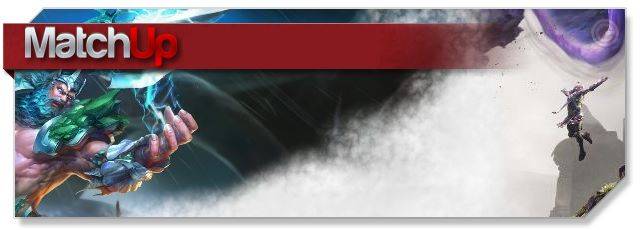MatchUp: SMITE vs Paragon

We’re pairing up two of the biggest third person MOBA titles on the market right now, SMITE (Hi-Rez Studios) and Paragon (Epic Games), a constant comparison and contest is made between these two due to their third person camera perspective (over a classic top down/isometric MOBA point of view), but there’s far more to both games than the third person label.
Both games are free to download and play for the various platforms they support with Smite being accessible on Windows, Mac, Xbox One and PS4 (and accessible through the Steam platform), and Paragon being spread between Windows and the PS4. Smite was released for nearly 2 years before Paragon’s “open beta” began, so it’s not a surprise the older title covers more bases, though the introduction of Mac and Xbox One for Smite only came in 2016, though there are no current plans for Paragon to bridge into the other platforms, particularly Xbox One.
As it stands Smite has a good head start on Paragon insofar as playable heroes, with a current roster of 86 deities that can be played from various real world pantheons, Paragon is already looking at a healthy 30 Heroes to choose from. Smite releases a patch every two weeks with a new character coming every other patch, making it around one new God per month, slightly overshooting Paragon’s “one hero every 3 weeks” statement, but with it being early days we’ll see how they keep up with that. If both developers keep to these release schedules then Paragon will be on even footing with Smite for number of characters in about 11 years’ time.
The aggressive rollout of Heroes for Paragon helps in part due to their limitation on maps and game modes, with only the single “Monolith” map, a new revision of their old “Legacy” map, which is a traditional three lane base push with waves of minions. In contrast Smite seems to value maps and modes more with a variation of ten different modes and each having their own map that switches up number of players per team, number of lanes, and various other mechanics. Smite really pushes the boundaries with their mode design with the introduction of the new Adventures, including the most recent “Apollo’s Racer Rumble” which introduced a temporary Mario Kart style racing game collecting weapons and battling your way around a track. Paragon is currently working on some new modes but has no current release or details.
When it comes to the maps one of the biggest things that separates Paragon from Smite, and really divides the all-too-straightforward “third person moba” title, is that Paragon utilized full vertical combat falling in line more with it playing like a third person shooter with MOBA mechanics. With various height levels from upper bridges and cliffs, to lower jungle areas, the map layout defines the combat more than anything else. This is made even more impressive with the use of the Unreal Engine 4 graphics (Smite used Unreal Engine 3), interestingly the Unreal Engine itself that is used globally by a number of developers for their titles (TERA, BLESS, Borderlands 2, Bioshock Infinite) was actually developed by Epic Games themselves.
Another element that separates the two games is the use of “items”, or in the case of Paragon “cards”. Smite uses a more traditional in-match item shop similar to those seen in League of Legends and DOTA 2, where players earn gold through the match and spend it to either purchase new items or upgrade old ones to improve them and gain additional bonuses for higher tiers. Paragon has implemented a more card collecting game element where you build your own deck from collectable cards and you place them into your six active card slots during a game by earning Card XP through combat interestingly (a similar system seen in Paladins, a first person base attack shooter developed by Hi-Rez Studios). Cards come in all shapes and sizes and player can build a deck to suit their playstyle, however, they do need to unlock them so there is an element of luck and/or grind to get the best cards from Card Packs, as opposed to Smite where all items are available in game to all players. Fortunately Paragon does have a card crafting system to allow an easier customization of your deck, combined with the fact that Card Packs can only be purchased with in-game play to earn “Reputation” and cannot be bought with cash or the Coins premium currency, which would potentially create some balancing pay to win issues.
When it comes to monetization again both games seem to go in their own direction; Smite has a number of gods on rotation each week for free, or players can rent or purchase new characters with play-to-earn “Favor” points, or through premium Gems, with all gods costing 200gems, which can be bought for $4.99 or earned through a handful of ways in game. Paragon on the other hands provides all their heroes for free in a similar fashion to Overwatch and Dota 2, using their free “Reputation” currency for purchasing card packs and skins, and their premium Coin currency focusing on buying emotes and other cosmetics and convenience items.
Overall there’s more that separates the two games than makes them similar, there’s a completely different play style and skillset required, completely different mechanics and features, different business models and priorities. Smite has the experience and has been around for longer, but Paragon definitely has the potential to go far, hold its own, and at some point stop being compared to Smite.

MatchUp: SMITE vs Paragon













